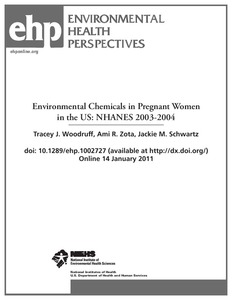Environmental chemicals in pregnant women in the US: NHANES 2003-2004
"Background: We analyzed biomonitoring data from the National Health and Nutritional Examination Survey (NHANES) to characterize both individual and multiple chemical exposures in U.S. pregnant women. Methods: We analyzed data for 163 chemical analytes in 12 chemical classes for subsamples of 2...
| Main Authors: | , , |
|---|---|
| Institution: | ETUI-European Trade Union Institute |
| Format: | TEXT |
| Language: | English |
| Published: |
Environmental Health Perspectives
2011
|
| Subjects: | |
| Online Access: | https://www.labourline.org/KENTIKA-19170914124919981969-environmental-chemicals-in-pre.htm |
| Summary: | "Background: We analyzed biomonitoring data from the National Health and Nutritional Examination Survey (NHANES) to characterize both individual and multiple chemical exposures in U.S. pregnant women. Methods: We analyzed data for 163 chemical analytes in 12 chemical classes for subsamples of 268 pregnant women from NHANES 2003-2004, a nationally representative sample of the U.S. population. For each chemical analyte, we calculated descriptive statistics. We calculated the number of chemicals detected within the following chemical classes; polybrominated diphenyl ethers (PBDEs), perfluorinated compounds (PFCs), organochlorine pesticides, and phthalates, and across multiple chemical classes. We compared chemical analyte concentrations for pregnant and non-pregnant women using least square geometric means, adjusting for demographic and physiological covariates. Results: The percent of pregnant women with detectable levels of an individual chemical ranged from 0 to 100 percent. Certain PCBs, organochlorine pesticides, PFCs, phenols, PBDEs, phthalates, polycyclic aromatic hydrocarbons (PAHs) and perchlorate were detected in 99 to 100% of pregnant women. The median number of detected chemicals by chemical class ranged from 4 (out of 12 PFCs) to 9 (out of 13 phthalates). Across chemical classes, median number ranged from 8 (out of 17 chemical analytes) to 50 (out of 71 chemical analytes). We found, generally, levels in pregnant women were similar or lower than levels in non-pregnant women, adjustment for covariates tended to increase levels in pregnant women compared to non-pregnant women. Conclusions: Pregnant women in the U.S. are exposed to multiple chemicals. Further efforts are warranted to understand sources of exposure and implications for policy-making." |
|---|---|
| Physical Description: | 41 p. Digital |

